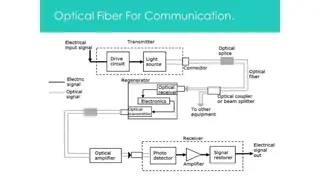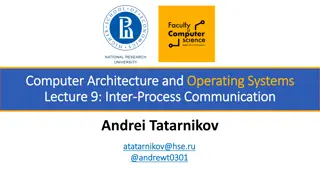Cognitive Load Classification with 2D-CNN Model in Mental Arithmetic Task
Cognitive load is crucial in assessing mental effort in tasks. This paper discusses using EEG signals and a 2D-CNN model to classify cognitive load during mental arithmetic tasks, aiming to optimize performance. EEG signals help evaluate mental workload, although they can be sensitive to noise. The
0 views • 19 slides
APAC Position, Navigation, and Timing Solution Market Analysis & Forecast
The Asia-Pacific position, navigation, and timing (PNT) solution (satellite) market is estimated to reach $1,410.5 million by 2033 from $466.1 million in 2023, at a CAGR of 11.71% during the forecast period 2023-2033.\nRead Report Overview: \/\/bisresearch.com\/industry-report\/asia-pacific-position
11 views • 3 slides
Position, Navigation, and Timing Solution Market Forecast to 2033
The global position, navigation, and timing (PNT) solution (satellite) market is estimated to reach $5.24 billion in 2033 from $1.23 billion in 2022, at a CAGR of 10.85% during the forecast period 2023-2033.\nRead Report Overview: \/\/bisresearch.com\/industry-report\/position-navigation-timing-solu
0 views • 3 slides
Understanding Telecommunications Transmission Systems
Transmission systems in telecommunications provide circuits between network nodes using channels for bidirectional communication. Channels can range from simple audio circuits to complex satellite systems. Signals can be analog or digital, each with its unique characteristics. Bandwidth is crucial f
0 views • 32 slides
Understanding D Latches and Flip-Flops in Digital Systems
Digital systems rely on storage elements like D latches and flip-flops to store key information from the past. These structures can hold values of 1 or 0 based on certain control signals, ensuring deterministic behavior. Clock signals are essential for regulating when these storage elements can upda
0 views • 15 slides
Understanding Data and Signals in Networks
Data transmission involves converting information into electromagnetic signals for communication. Analog data is continuous, like a clock's hands, while digital data is discrete, like binary code in computer memory. Signals can be analog or digital, periodic or non-periodic, with characteristics lik
0 views • 17 slides
Interfacing with Analog Signals in Embedded Systems
Exploring the conversion of analog signals from the physical world into electrical signals using transducers in embedded systems. Learn about going from analog to digital representation, choosing sample rates, the Shannon-Nyquist sampling theorem, importance of anti-aliasing filters, and the necessi
0 views • 18 slides
Machine Learning for Predicting Path-Based Slack in Timing Analysis
Utilizing machine learning to forecast path-based slack in graph-based timing analysis offers a solution for optimizing power and area efficiency in the design process. The Static Timing Analysis incorporates accurate path-based analysis (PBA) and fast graph-based analysis (GBA) to estimate transiti
1 views • 31 slides
Understanding Inter-Process Communication Signals in Operating Systems
Signals in inter-process communication are asynchronous notifications delivered to specific processes, allowing event-based programming. Processes can handle signal delivery by ignoring it, terminating, or invoking a signal handler. Signal handlers can be written in two ways - one handler for many s
0 views • 21 slides
Understanding Bandwidth and Digital Signals in Computer Networks
Exploring the concept of bandwidth in computer networks, which refers to the range of frequencies in a signal, and delving into the decomposition of signals into simple sine waves using tools. Additionally, the discussion covers digital signals, their representation, and the transmission of informat
1 views • 14 slides
Clear Channel Assessment (CCA) Behavior of Commercial Wi-Fi Equipment
This document, dated July 2022, delves into the Clear Channel Assessment (CCA) behavior of commercial Wi-Fi equipment in response to Narrowband Frequency Hopping (NB FH) signals. It explores the regulatory framework around license-exempt frequency bands in the USA and Europe, highlighting the specif
0 views • 22 slides
Understanding Analog Data and Digital Signal Transmission
This lecture delves into the concepts of analog data, digital signals, and the processes involved in data transmission and digital communication. It covers topics such as Pulse Amplitude Modulation (PAM), Analog-to-Digital Conversion, and Sampling. The conversion of analog signals to digital signals
0 views • 34 slides
Overview of Point-to-Point Fiber Optic Communication System
Point-to-point fiber optic communication systems involve converting voice signals from a microphone into digital signals using a coder, transmitting light signals through a semiconductor diode laser over optical fibers, and decoding the signals back to analog for sound production. The system offers
0 views • 11 slides
Designing a Traffic Signal Timing Plan: Steps and Guidelines
This comprehensive guide covers the essential steps involved in designing a traffic signal timing plan, including determining lane configurations, proposing phase plans, identifying critical volumes, recommending phase plans, and establishing clearance intervals. It also provides insights into aspec
1 views • 26 slides
TV Ads Signalling Success: Driving Strong Fitness, Trust, and Popularity Signals
TV ads play a crucial role in signaling success by driving strong fitness, social, trust, quality, confidence, and popularity signals among adults. The strength of these signals varies across different media channels, with television emerging as a powerful platform for engaging audiences. Fitness an
15 views • 14 slides
Understanding Sampling and Signal Processing Fundamentals
Sampling plays a crucial role in converting continuous-time signals into discrete-time signals for processing. This lecture covers periodic sampling, ideal sampling, Fourier transforms, Nyquist-Shannon sampling, and the processing of band-limited signals. It delves into the relationship between peri
1 views • 60 slides
Preventing Active Timing Attacks in Low-Latency Anonymous Communication
This research addresses the vulnerabilities of onion routing to timing attacks and proposes solutions to prevent active timing attacks, focusing on low-latency anonymous communication systems. Various problems related to timing attacks in onion routing are analyzed, including the role of adversaries
0 views • 52 slides
Numerical Abstract Domain with Max Operator in Timing Analysis
Explore a numerical abstract domain based on expression abstraction and the Max operator with applications in timing analysis. The challenges in timing analysis, such as disjunctive and non-linear bounds, are discussed along with simple examples illustrating these concepts. The difficulty of proving
0 views • 21 slides
Harvesting and Postharvest Techniques for Quality Seed Production
Understand the importance of harvesting crops at the right timing to maximize seed quality. Learn about half-matured and full-matured stages, postharvest ripening, and indicators for precise timing. Discover the significance of counting days from flowering/pollination for determining harvest timing.
0 views • 24 slides
Deconvolving Snow Cover and Snowfall Passive Microwave Signals
This research focuses on deconvolving snow cover and snowfall passive microwave signals using GPM data. The study employs a data-driven approach to estimate snowfall using a nested K-nearest algorithm and observed irregularities. By analyzing variations in brightness temperatures (Tbs) over snow-cov
0 views • 9 slides
EEG-Based BCI System for 2-D Cursor Control Combining Mu/Beta Rhythm and P300 Potential
Brain-computer interfaces (BCIs) offer a pathway to translate brain activities into computer control signals. This paper presents a novel approach for 2-D cursor control using EEG signals, combining the Mu/Beta rhythm and P300 potential. By simultaneously detecting two brain signals, P300 and motor
0 views • 27 slides
Effective Strategies for Locational Signals in Renewable Energy Projects
Locational signals play a crucial role in steering renewable energy project constructions to specific areas, aiding in grid optimization and resource utilization. Strategies like bid bonuses, penalties, and maximum capacity quotas help manage integration challenges and ensure sustainable deployment
0 views • 17 slides
IEEE802.15-14-0110-01-0mag MAC Timing Discussion Points for IEEE 802.15.4 Revision
Initial discussion document submitted by Benjamin A. Rolfe from Blind Creek Associates addressing MAC timing issues in the IEEE 802.15.4 standard revision. The document identifies potential problems, provides a list of questions for consideration, and outlines areas for improvement. It includes stat
0 views • 8 slides
Basis Production Procedure for AGATA through GRETINA Signal Decomposition
This presentation outlines the detailed procedure for generating basis signals in the context of AGATA data processed through GRETINA signal decomposition. It covers the generation of pristine basis signals, superpulse analysis, and the creation of cross-talk corrected basis files. The process invol
0 views • 19 slides
Understanding Inter-Process Communication in Computer Architecture
Explore the key concepts of Inter-Process Communication (IPC) in computer architecture, covering topics such as signals, message queues, shared memory, and handling signals. Learn how to send and handle signals, manage never-ending programs, and control processes using utilities like kill. Dive into
0 views • 20 slides
Cesarean Delivery Timing Guidelines for Women with Prior Uterine Scars
Society for Maternal Fetal Medicine provides cesarean delivery timing recommendations for women with prior uterine scars. For those with a history of classical cesarean, the risk of uterine rupture guides the timing of repeat cesarean. Similarly, women with prior myomectomy should plan delivery betw
0 views • 10 slides
Embedded Computer Systems Lab 1: VGA Module Overview
This document provides an overview of Lab 1 for Embedded Computer Systems II, focusing on the VGA module and its functionalities. It includes details about the VGA module entity, its ports, clock signals, trigger voltage and time representation, channel signals, color intensities, row and column val
0 views • 18 slides
Applications of RC Circuits in Electronics and Biomedical Devices
RC circuits play a crucial role in various applications such as camera flashes, timing devices in automobiles, and heart pacemakers. These circuits involve charging and discharging a capacitor through a resistor, controlling voltage pulses for precise timing. In devices like camera flashes, the flas
0 views • 7 slides
NTN RRM Timing Related Requirements for Xiaomi Devices at 3GPP TSG-RAN4 Meeting #98-e
The agenda item for the 3GPP TSG-RAN4 Meeting #98-e involves discussing NTN RRM timing related requirements, specifically focusing on UE timing synchronization for Xiaomi devices. Key aspects include UE transmit timing error limits, timing advance accuracy, and UE timer accuracy requirements for NTN
0 views • 6 slides
WylasTiming - Wireless Semi-Automatic Timing System Overview
WylasTiming is a wireless semi-automatic timing system developed in Australia, utilizing off-the-shelf hardware and Android handsets. It provides accurate timing with automatic race starting and instantaneous data transmission. The timekeeper simply stops the clock at the end of the race, and data i
0 views • 15 slides
Simplifying Post-Silicon Timing Diagnosis with NGSPA Tool
Explore how the NGSPA tool by Intel simplifies post-silicon timing diagnosis, replacing costly machines with a CAD application running on an x86 server, saving resources and enabling parallelized CAD operations. Learn about the challenges in post-silicon speed debugging, the importance of static tim
0 views • 26 slides
Understanding Timing Models in Cell Design Environments
Delve into the intricacies of timing models for cells in design environments, exploring factors affecting delay, output transitions, linear and non-linear models, and the use of table models in cell libraries to specify delays and timing checks. Discover how input transitions and output capacitance
0 views • 11 slides
Understanding Timing Vulnerabilities in Computing Systems
Explore the evolution of timing attacks in computing systems, from traditional crypt-analysis to modern web-focused techniques. Discover the gap in implementing security measures and how universities can bridge this disparity. Delve into the history, challenges, and implications of timing vulnerabil
0 views • 26 slides
Discussion on Timing Mask Requirement for ULSUP-TDM in RAN4#94e Meeting
In the RAN4#94e and #94e-Bis meetings, discussions were held on the timing mask requirement for ULSUP-TDM, particularly focusing on sub-topics like evaluating uplink timing differences between LTE and NR, clarifying present time mask conditions, and testing time mask requirements. The key issue cent
0 views • 4 slides
Understanding Static Timing Analysis in Advanced VLSI Design
Static timing analysis is a crucial aspect of VLSI design, helping predict chip performance before fabrication. This article explores the importance of static timing analysis, its effectiveness, and the limitations of dynamic simulation tools like SPICE. Learn about the challenges in testing critica
0 views • 76 slides
Advancing AMS Assertions for Analog/Digital Interface Verification
AMS assertions play a crucial role in verifying analog/digital interfaces, checking properties related to voltages, currents, and complex timing constraints. They bring advantages similar to SVAs in digital verification, addressing specific AMS requirements. Examples showcase comparisons of voltage/
0 views • 11 slides
Understanding Sequential Circuit Timing and Clock Frequency
Sequential circuit timing is crucial for designing digital systems. The minimum clock period, slack values, clock frequency, and critical paths play key roles in determining the operational speed and performance of sequential circuits. By analyzing flip-flop timing parameters, combinatorial logic de
0 views • 20 slides
Understanding Variable Valve Timing (VVT) in Internal Combustion Engines
Variable Valve Timing (VVT) optimizes engine performance by adjusting valve duration, timing, and lift according to engine speed, enhancing torque, power, and fuel efficiency. VVT operates by varying intake valve opening/closing, regulating valve timing, and adjusting lift for better volumetric effi
0 views • 14 slides
Understanding Covert Timing Channels in Network Security
Covert timing channels are a method of leaking sensitive information across networks by violating security policies. These channels rely on conveying information through packet arrival patterns rather than the contents of the packets. Military applications, detection by USA government agencies, and
0 views • 26 slides
Civilian GNSS Signals Overview: GPS, GLONASS, Galileo
An insightful lecture on civilian GNSS signals by Dr. Ali Albu-Rghaif covers GPS, GLONASS, and Galileo signals. The content delves into GPS signal modulation, generation, receiving, and demodulation processes, highlighting the carrier wave, navigation data, and spreading sequences. It also discusses
0 views • 20 slides






































